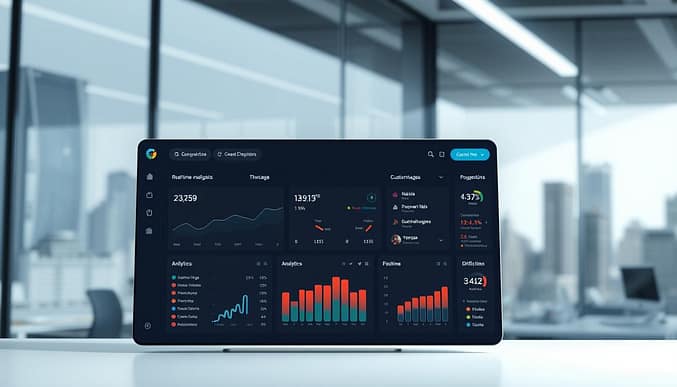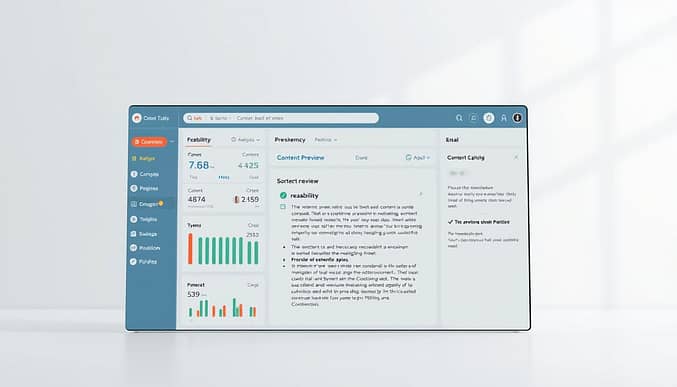Top SEO Writing Assistant: SEMrush Features for 2023
Creating high-performing content requires more than just creativity. In 2023, writers need tools that analyze real-time data while suggesting improvements. One platform stands out for its ability to streamline workflows across popular platforms like Google Docs and WordPress.
This solution offers instant feedback on readability, keyword usage, and originality. It helps refine drafts by identifying areas where content might feel repetitive or overly technical. Users can also access AI-powered suggestions to rephrase sentences or generate new ideas without leaving their workspace.
For teams working on tight deadlines, the tool’s integration flexibility eliminates constant app-switching. Whether drafting blog posts or updating website copy, its recommendations adapt to different content types. The platform even provides tiered access levels, making it scalable for freelancers and large organizations alike.
Curious how to set it up? Our guide breaks down practical installation steps and advanced optimization tactics. You’ll learn to maximize features like plagiarism checks and tone adjustments while maintaining your unique voice.
Key Takeaways
- Real-time optimization helps improve content quality during drafting
- Works seamlessly with Google Docs, WordPress, and Microsoft Word
- Provides readability scores and plagiarism detection alerts
- Includes AI tools for rewriting sentences and generating ideas
- Subscription plans cater to different team sizes and needs
Introduction to SEMrush’s SEO Writing Assistant
In today’s digital landscape, producing effective content requires data-driven insights. This platform acts as a central hub for refining drafts, ensuring they meet both reader expectations and search engine requirements. Writers receive instant feedback on clarity, uniqueness, and alignment with trending topics.

Overview and Purpose
The tool simplifies quality checks by scanning text for redundancies, complex phrasing, and keyword distribution. Its primary goal? To turn rough drafts into polished pieces that rank higher and engage audiences. For example, it flags sentences like “utilize” and suggests simpler alternatives like “use.”
“Real-time feedback transforms drafts from good to great by aligning them with search trends.”
Real-Time SEO Metrics
As you type, the dashboard updates scores for readability, originality, and keyword usage. Here’s how it works:
| Feature | Benefit | Impact |
|---|---|---|
| Originality Check | Flags duplicate content | Prevents plagiarism risks |
| Readability Score | Highlights complex sentences | Improves audience retention |
| Keyword Integration | Tracks target phrase frequency | Boosts search visibility |
| Real-Time Updates | Instant feedback during drafting | Reduces revision time |
For teams managing multiple projects, the tool’s plagiarism detection ensures every piece is 100% unique. It cross-references databases to highlight matches, letting writers rephrase problematic sections on the spot. Curious how it compares to other solutions? Explore this comprehensive guide for side-by-side feature breakdowns.
Understanding the Key Benefits of Using SEMrush Tools
Crafting standout content demands balancing creativity with measurable improvements. Modern platforms now offer actionable insights to elevate quality while saving time. Let’s explore how these solutions address common challenges like clarity, uniqueness, and brand alignment.

Boosting Content Readability and Originality
Clear communication starts with simplicity. The tool scans drafts for jargon or run-on sentences, suggesting shorter alternatives. For instance, it might flag “commence” and recommend “start” instead. Real-time scores track progress, helping writers meet grade-level targets effortlessly.
Originality matters just as much. The system cross-references billions of web pages to highlight potential duplicates. One user noted:
“It caught a paragraph I’d unintentionally paraphrased from an old blog post. Fixing it took seconds.”
| Feature | Function | Outcome |
|---|---|---|
| Readability Check | Identifies complex phrasing | Simplifies messaging |
| Plagiarism Scan | Detects duplicate content | Ensures uniqueness |
| Tone Analysis | Flags inconsistent language | Strengthens brand voice |
Maintaining a Consistent Tone of Voice
Brands thrive on recognizable messaging. AI-powered recommendations analyze word choice and sentence structure to align content with predefined guidelines. Whether your style is casual or formal, the tool nudges writers toward phrasing that resonates.
Semantic keywords further refine this process. By suggesting related terms, it helps content rank for broader search queries without sounding forced. Teams can also monitor website performance metrics to spot trends and adjust strategies.
Installation and Integration Across Platforms
Streamlining workflows starts with seamless tool integration. The platform connects effortlessly with widely used programs, letting teams focus on refining content rather than technical setups.
Google Docs Add-On Setup
Install the Google Docs add-on in three steps via the Google Workspace Marketplace. Click “Install,” grant permissions, and access its features through the sidebar. Real-time suggestions appear as you type, with no need to toggle between tabs.
WordPress Plugin and MS Word Add-On Procedures
WordPress users install the plugin from their dashboard, then link their Semrush account in the settings. For Microsoft Word, select “Get Add-ins” from the Insert menu and search for the tool. Both versions offer identical core features but adapt their interfaces to match each platform’s layout.
Pro tip: Sync your Semrush account during setup to unlock advanced quality checks. This ensures keyword tracking and plagiarism scans pull data directly from your projects. Teams managing multiple platforms appreciate the consistent design across Google Docs, WordPress, and Word versions.
Creating New Recommendations and SEO Content Templates
Building content that resonates requires precision. The platform’s template builder lets users craft frameworks tailored to specific goals. Start by entering primary target phrases and selecting locations to prioritize local search trends. This step ensures recommendations align with regional preferences and device-specific behaviors.
Setting Target Keywords and Locations
Adjust parameters in three clicks: choose phrases, set geographic focus, and pick devices (desktop/mobile). For a blog targeting “coffee shops in Austin,” the tool suggests related terms like “best espresso downtown” and adjusts metrics based on Texas search patterns. Location settings also influence competitor analysis, highlighting gaps in nearby markets.
| Parameter | Adjustment | Impact |
|---|---|---|
| Keyword | Add synonyms | Broadens reach |
| Location | Set radius | Targets local traffic |
| Device | Mobile priority | Optimizes snippets |
Analyzing the Score Graph and Metrics Breakdown
The score graph displays four pillars: search relevance, readability, originality, and tone. Each feature updates dynamically as you edit. A low originality rating might prompt rewrites, while a high readability score confirms clear messaging. One marketing team shared:
“Tweaking our post based on the graph boosted organic traffic by 40% in two weeks.”
Regularly refresh templates to reflect algorithm changes. The system parses top-performing blog content to suggest new angles, ensuring your section stays competitive without manual research.
How to Use seo writing assistant semrush for Real-Time Optimization
Modern content creators face tight deadlines while juggling quality standards. Real-time optimization tools bridge this gap by offering instant adjustments as you draft. These features analyze text structure, word choice, and originality while suggesting improvements—all without interrupting your workflow.
Streamlining Edits With AI Enhancements
The rephraser tool simplifies complex sentences instantly. Highlight a phrase, and it offers 3-5 alternatives that maintain meaning while improving reading flow. For example:
- “Commence operations” → “Start working”
- “Utilize resources” → “Use tools”
This approach resolves issues like repetitive phrasing before they reach editors. Teams report saving 2-3 hours per document by addressing problems during drafting.
| Feature | Action | Outcome |
|---|---|---|
| Rephraser | Rewrites sentences | Boosts clarity |
| Compose | Generates new paragraphs | Saves research time |
| Plagiarism Check | Scans existing content | Reduces legal issues |
The Compose feature tackles writer’s block by suggesting relevant ideas. Input a topic like “sustainable packaging trends,” and it outlines key points with supporting data. One user noted:
“It helped me draft a technical whitepaper in half the usual time while avoiding plagiarism risks.”
Balance remains crucial. Tools flag potential issues, but human judgment ensures tone and intent stay on track. Review suggestions before applying them to maintain your unique voice across every document.
In-Depth Feature Analysis for Content Optimization
Content creation tools have evolved beyond basic grammar checks. Advanced platforms now offer detailed audits that improve quality while streamlining team workflows. These features help business users maintain consistency across projects while meeting strict deadlines.
Advanced Link and Readability Audits
Broken links harm user experience and credibility. The system scans articles to flag outdated URLs, suggesting replacements from your internal database. Readability analysis goes beyond word length, assessing sentence rhythm and transition flow.
One marketing team noted:
“Fixing flagged issues reduced bounce rates by 18% in one month.”
| Feature | Function | Outcome |
|---|---|---|
| Link Analysis | Identifies broken connections | Improves site navigation |
| Readability Scoring | Evaluates sentence complexity | Boosts audience retention |
| Plagiarism Check | Scans for duplicate text | Protects brand reputation |
Originality Protection and Team Coordination
Plagiarism reports highlight matches across billions of web pages. Writers receive a list of flagged sections with rewrite suggestions. For teams, version tracking lets multiple users edit documents without overwriting changes.
Collaboration features include:
- Color-coded edit histories
- Comment threads for feedback
- Approval workflows for managers
These insights help businesses scale content production while maintaining editorial standards. Real-time updates ensure all team members work with the latest draft, reducing communication gaps.
Best Practices and Strategies for Effective Content Creation
Mastering content creation involves blending strategy with practical tools. Teams that track progress and refine processes see faster results. Let’s explore how to turn insights into action while keeping workflows smooth.
Integration of Recommendations Into Your Workflow
Start by setting measurable goals. Track the number of target phrases per piece and monitor link placements. Use templates to standardize title formats, saving 10–15 minutes per draft.
Assign team members specific roles through your account dashboard. Writers focus on drafting, editors review tone, and managers approve final versions. This division prevents bottlenecks during high-volume periods.
| Strategy | Tool Used | Outcome |
|---|---|---|
| Title Optimization | Headline Analyzer | 22% More Clicks |
| Internal Linking | Link Audit Tool | 35% Lower Bounce Rate |
| Collaboration | Shared Workspaces | 50% Faster Approvals |
Real-World Examples and Success Stories
A Midwest marketing agency boosted client traffic by 60% in six months. They used performance dashboards to identify underperforming titles and updated 30+ posts. One team member shared:
“Revising headlines based on freshness scores tripled our social shares.”
Another example: An e-commerce brand improved product page conversions by linking related guides. They added 12–15 internal links per page, keeping visitors engaged longer. Regular audits ensured all connections stayed relevant.
Key takeaways for teams:
- Update templates quarterly to reflect algorithm changes
- Set account alerts for sudden traffic drops
- Test 3–5 title variations before finalizing
Conclusion
Elevating your content strategy starts with tools that simplify complex tasks. The platform discussed here delivers real-time feedback through an intuitive interface, helping writers refine drafts without disrupting their workflow. Its ability to flag repetitive phrasing and suggest clearer alternatives makes it stand out among competitors.
Integrated workflows eliminate app-switching, letting teams focus on quality. Features like plagiarism scans and readability scores ensure every piece meets high standards. Unlike other tools, its menu-driven process adapts to various content types, from blogs to product descriptions.
For those seeking efficiency, this solution reduces editing time while improving search performance. A detailed review here highlights how its interface outperforms alternatives through seamless Google Docs integration and AI enhancements.
Ready to transform your process? Start by testing its recommendations on your next project. The results—higher engagement and better rankings—speak for themselves.